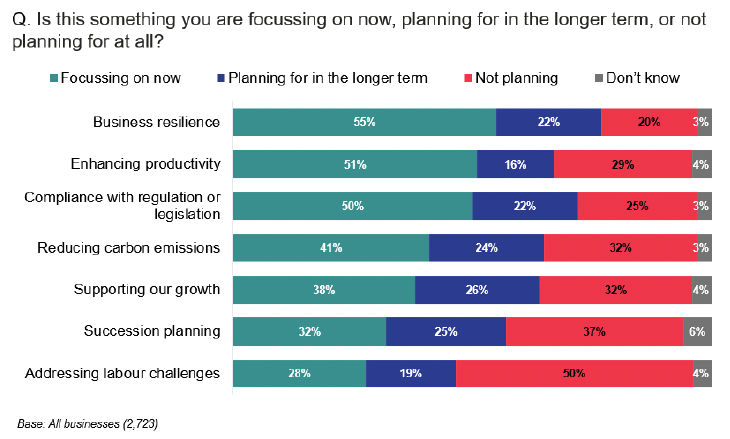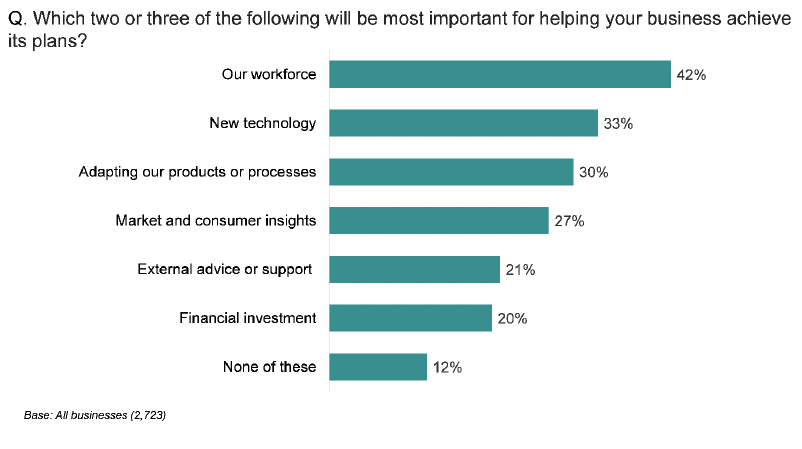Rural Scotland Business Panel Survey
This report presents findings from the second Rural Scotland Business Panel Survey carried out in February and March 2022.
4. Planning ahead
Key findings
At least half of businesses were currently focussing on their resilience (55%), enhancing productivity (51%), and compliance with regulation or legislation (50%). Fewer than half were currently focussing on reducing carbon emissions (41%), supporting growth (38%), succession planning (32%), and addressing labour challenges (28%).
The most important factor in helping businesses achieve their plans was their workforce (42%), followed by new technology (33%), and adapting their product or processes (30%). Other important factors included market and consumer insights (27%), external advice and support (21%), and financial investment (20%).
Areas of focus
At least half of businesses were currently focussing on their resilience (55%) enhancing productivity (51%), and compliance with regulation or legislation (50%).
Fewer than half of businesses were currently focussing on reducing carbon emissions (41%), supporting growth (38%), succession planning (32%), and addressing labour challenges (28%) (Figure 4.1).
For around a quarter of businesses, supporting growth (26%), succession planning (25%), and reducing carbon emissions (24%) were areas they were planning for in the longer term. Around one in five businesses were making longer term plans for the other areas (compliance with regulation or legislation, resilience, labour challenges, and enhancing productivity).
The areas that businesses were least likely to be planning for at all were addressing labour challenges (50% were not planning) and succession planning (37%).

Variation in areas of focus
Businesses in the Highlands and Islands were more likely than those in the South of Scotland and rest of rural Scotland to be focussing on each area. The exception was compliance with regulation or legislation, which was more of a focus for businesses in the South of Scotland (55%).
Large businesses (25+ staff) were more likely to be focussing on all areas, while Sole trader and microbusinesses (0-4 staff) were more likely to not be planning for these areas at all.
Certain sectors showed different priorities in terms of their areas of focus:
- Tourism – more likely to be focussing on business resilience (64%) and addressing labour challenges (39%).
- Financial and businesses services – focussing on compliance with regulation and legislation (57%), but not planning for addressing labour challenges (61%) and reducing carbon emissions (49%).
- Food and drink – focussing on enhancing productivity (58%), reducing carbon emissions (52%), and succession planning (46%).
- Creative industries – not planning at all for addressing labour challenges (69%), supporting growth (44%), or reducing carbon emissions (40%).
Women-led businesses were more likely than those led by men to be focussing on supporting their growth (44% vs 35%).
Businesses operating above pre-pandemic levels, those optimistic about their future, and those striving for growth more likely to be focussing on most areas.
Labour challenges
As might be expected, addressing labour challenges was more of a focus for those that currently employed staff, than for those with no staff.
- Among employers, 33% were currently focussing on addressing challenges, while 21% were planning for this in the longer term (and 43% were not planning at all).
- Most (73%) of those with no staff were not planning on addressing labour challenges. However, 10% said this was a current area of focus for them, and 10% were planning for it in the longer term.
Among those that were experiencing workforce-related issues (see chapter 5), 43% were currently focussing on addressing labour challenges, while 26% were planning to do so in the longer term. However, 29% of those experiencing workforce-related issues were not planning to address those challenges (and this group were also more likely than average to say they were not planning for any of the aspects listed).
Helping business achieve plans
The most important factor in helping businesses achieve their plans was their workforce (42%), followed by new technology (33%) and adapting product or processes (30%). Other important factors included market and consumer insights (27%), external advice and support (21%) and financial investment (20%). Around one in ten (12%) said none of these factors were important in helping them achieve their plans (Figure 4.2).

Variation in helping business achieve plans
The following types of business were more likely to say certain factors were important to helping them achieve their plans.
- Food and drink – new technology (38%), financial investment (29%) and external advice and support (28%).
- Tourism – market and consumer insights (37%).
- Financial and business services – new technology (43%).
- Creative industries – new technology (42%) and adapting product or processes (41%).
- Islands businesses – workforce (51%), financial investment (25%), and external advice and support (26%).
- Large businesses (25+ staff) – workforce (83%), new technology (43%) and financial investment (28%).
Businesses striving for growth were more likely to say most factors were important, while those looking to downsize were more likely to say none of the factors were important.
Contact
Email: socialresearch@gov.scot
There is a problem
Thanks for your feedback